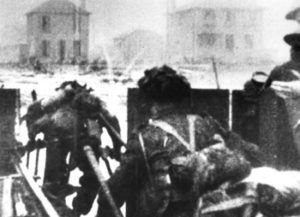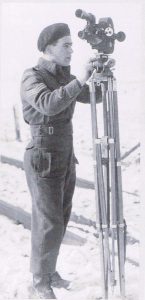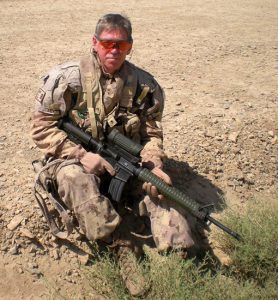
He was supposedly the warm-up act. He was Tim Isberg, a singer-songwriter from Fort Macleod, Alberta. And I was supposedly the main event, offering a talk about veterans’ stories, and how I came by them. But, as I sat there waiting for Isberg to finish his set, I was mulling over a problem in my head. I wasn’t quite sure where to start my presentation. Suddenly, I paid attention to what Isberg was singing.
“Listen to the voice,” he sang in a calming sort of way. “Listen to the voice calling me … calling you.”
And it hit me. All week long, I’d been organizing my thoughts for this presentation, loosely based on a book about veterans’ post-traumatic stress disorder, but I hadn’t decided whose experience, whose story to start with. Then, this voice in my head – yes, a voice calling me – suggested I tell the story of an old friend I’d known in the Edmonton area, where I was about to speak.

Chuck Ross’s story related to that famous film footage we see every year during the D-Day anniversary. It’s the movie showing troops inside a landing craft. They’re passing around weapons, waiting for the landing craft doors to open. When they do, you can plainly see the men dashing toward gunfire on a beach. It’s film of Canadians landing on Juno Beach on June 6, 1944.
“I’d always wondered how that incredible film footage was captured,” I explained the Alberta audience. “I’d researched the subject and read that the film was shot from a camera locked down at the back of the landing craft…”
The problem was I didn’t believe it. So, I told my audience, I went searching for an eye-witness. That led me to Chuck Ross from Edmonton. About age 20 when he enlisted, Ross knew how to operate a camera, so the army made him a cinematographer in the Canadian Film and Photo Unit (CFPU), shooting action footage of troops liberating Italy, France, Belgium, Holland and Germany. When I found Ross, he told me that he’d landed on Juno Beach a couple of days after D-Day.

But, I didn’t pop the big question right away about whether or not the famous footage was shot from a locked-down camera. First I asked him about the operation of the camera. He told me it was a Bell & Howell Eyemo camera, powered by a clockwork spring that was wound up with a key, like a child’s toy. The film was 35-millimetre motion picture.
“No wonder the image is so clear and precise,” I said. But now I was getting closer to the issue of the film’s origin. “How much shooting time would one full winding with the key give the camera operator?”
“About 35 or 36 seconds,” Ross said.
“That’s all?” I said. “Well, what do you think of the commonly held belief that the film was actually shot by a camera simply mounted in the back of the landing craft?”
“Not true,” he roared. “It was shot by Bill Grant!” And he proceeded to tell me that Grant’s footage, on D-Day itself was removed from the camera, placed in a sealed can, sent back to England aboard a returning troopship, passed along to London for processing, censor-clearance, editing, and then it was released in newsreel theatres in the U.K., U.S. and Canada within a day or two.

I went on to explain to my audience in Alberta, last Thursday, that CFPU cinematographers travelled with Canadian troops in the front lines, armed only with a camera, tripod and reels of unexposed film. Chuck Ross emphasized that CFPU cameramen got incredible footage not by hiding behind the lines, but by operating alongside the soldiers. As a consequence, Ross said, four of them died of wounds shooting the film, and another 20 were wounded. I suggested to him that he’d experienced extraordinary moments of Canada’s past.
“For some, it’s history,” Ross said. “For us, it will always be yesterday.”
And I realized in that instant, that sometimes a soldier’s PTSD is more obvious than we realize. And as I spoke of other vets and their coping skills last Thursday, I thought some more about Tim Isberg’s “voice,” since he too is a Canadian Forces veteran. He’d served with Gen. Romeo Dallaire in Rwanda, investigating mass graves in the aftermath of the genocide there. During a posting to the Middle East in 2006, Maj. Isberg had assisted the evacuation of refugees from Lebanon.

Then, in Afghanistan, as a language staff officer he ran a literacy program – finding curriculum, teachers and education tools – to help Afghan army, police and civilians learn to read manuals, reports, licence plates and even ID cards.
“I’ve been fortunate my military career was eventful,” he told a reporter from the St. Albert, Alberta, Gazette.
It’s also given him a different voice than most people hear. Sometimes that voice comes through in the lyrics he’s composed and recorded now on several CDs, his most recent “Tears Along the Road.”
But because he’s also a veteran, that voice helps him channel experience and wisdom to others, even if they don’t recognize it immediately.